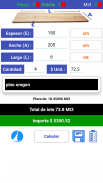









Calculador Madera Pie tablar

Descriere Calculador Madera Pie tablar
Calculador Pie cuadrado de madera aserrada o pie tablar.
** Nuevo: Opción de resultado en metros cubico. **
La fórmula para realizar el cálculo de volumen de madera aserrada es la siguiente:
Dónde:
Pt o P2 = Pie tablar o pie cuadrado
E” = Espesor de la madera en pulgadas
A” = Ancho de la madera en pulgadas
L´ = Largo de la madera en pies
Pt = (E” x A” x L)/ 12
Ejemplo: Espesor (E) = 2” , ancho (A) = 6” y longitud (L) = 15’
Volumen (Pt) = (2” x 6” x 15’) /12 = 15 Pt o P2
En 1 mt3 (metro cubico) de madera aserrada existen 424 pies tablares de madera.
En 1 Ft3 (Pie cubico) de madera aserrada existen 12 pies tablares de madera.
En 1 pie tablar = 1’ancho x 1’largo x 1”espesor
En esta aplicación puede obtener el resultado en (Pt - Pie2 - ft2 - Pie cuadrado).
Esta es la medida que se utiliza generalmente para calcular la cantidad de madera "aserrada o cortada en las cuatro caras" (Tabla, Tirante, Viga, placa).
En base a esta medida se puede calcular la cantidad y precio del producto que necesite.
Para este cálculo, Usted debe ingresar el espesor, ancho, largo y cantidad de piezas para obtener el resultado unitario y Total de Pt/P2/Ft2.
Puede también activar en la parte superior el filtro de Precio para agregar este dato a su cálculo.
Hay también un filtro de Detalle, donde puede ingresar alguna anotación de referencia.
Estos datos pueden ser guardados presionando el icono correspondiente. Una vez guardada la información le mostrara el listado de Datos guardados con el nuevo registro ubicado al final.
Dispone de un botón para ver el listado de información almacenada y en la parte superior una barra de herramientas que le permiten:
Buscar (filtrar información del listado ingresando la misma).
Compartir (compartir los datos guardados como texto simple).
Vaciar (Eliminar todos los Datos).
Cuando seleccione algún registro de la lista aparecerá un icono con un fichero rojo que le permite eliminar solo el registro seleccionado.
1. Debe seleccionar la Unidad de medida a ingresar en el cuadro de Espesor presionando el botón gris "Elija".
2. Ingrese el Espesor tocando el cuadro de texto Blanco con el título "Alto"
3. Debe seleccionar la Unidad de medida a ingresar en el cuadro de Ancho presionando el botón gris "Elija"
4. Ingrese el Espesor tocando el cuadro de texto Blanco con el título "Ancho"
5. Debe seleccionar la Unidad de medida a ingresar en el cuadro de Largo presionando el botón gris "Elija"
6. Ingrese el Espesor tocando el cuadro de texto Blanco con el título "Largo"
Nota: las unidades de espesor y ancho pueden ser (centímetro "cm", pie, pulgada "pulg" ) y el largo en (metro "mt", pie, pulgada "pulg").
En el comercio de madera aserrada encontramos productos como tablas, vigas, listones, placas y madera dimensionada en general, la comercialización se realiza en pie tablar, esta unidad de comercialización se maneja a nivel nacional e internacional.
La unidad de pie tablar proviene del comercio de madera que se realizaba en los Estados Unidos y los países Europeos, esta unidad de comercialización se adoptó en el país y su usa actualmente, para el comercio de madera aserrada.
Un pie tablar es equivalente al resultado de la medición de una pieza de madera con las siguientes medidas, un pie de ancho por un pie de alto y de espesor una pulgada.
Calculator Square foot of sawn wood or board foot.
** New: Option of result in cubic meters. **
The formula for calculating the volume of sawn wood is as follows:
Where:
Pt or P2 = Tabular foot or square foot
E ”= Thickness of wood in inches
A ”= Width of wood in inches
L´ = Length of wood in feet
Pt = (E ”x A” x L) / 12
Example: Thickness (E) = 2 ”, width (A) = 6” and length (L) = 15 ’
Volume (Pt) = (2 ”x 6” x 15 ’) / 12 = 15 Pt or P2
In 1 mt3 (cubic meter) of sawn wood there are 424 wooden plank feet.
In 1 Ft3 (cubic foot) of sawn wood there are 12 wooden plank feet.
In 1 board foot = 1’s width x 1’s length x 1 ”thickness
In this application you can get the result in (Pt - Foot2 - ft2 - Square foot).
This is the measure that is generally used to calculate the amount of wood "sawn or cut on all four sides" (Table, Strut, Beam, plate).
Based on this measure you can calculate the quantity and price of the product you need.
For this calculation, you must enter the thickness, width, length and quantity of pieces to obtain the unit and Total result of Pt / P2 / Ft2.
You can also activate the Price filter at the top to add this data to your calculation.
There is also a Detail filter, where you can enter some reference annotation.
This data can be saved by pressing the corresponding icon. Once the information is saved, it will show you the list of Saved Data with the new record located at the end.
It has a button to see the list of stored information and at the top a toolbar that allows you to:
Search (filter list information by entering it).
Share (share data saved as simple text).
Empty (Delete all Data).
When you select a record from the list, an icon will appear with a red file that allows you to delete only the selected record.
1. You must select the Unit of measure to enter in the Thickness box by pressing the gray "Choose" button.
2. Enter the Thickness by touching the White text box with the title "High"
3. You must select the Unit of measure to enter in the Width box by pressing the gray "Choose" button
4. Enter the Thickness by touching the White text box with the title "Width"
5. You must select the Unit of measure to enter in the Length box by pressing the gray "Choose" button
6. Enter the Thickness by touching the White text box with the title "Length"
Note: the units of thickness and width can be (centimeter "cm", foot, inch "in") and the length in (meter "mt", foot, inch "in").
In the trade of sawn wood we find products such as boards, beams, slats, plates and dimensioned wood in general.
The tabular foot unit comes from the timber trade that was carried out in the United States and European countries, this marketing unit was adopted in the country and is currently used for the trade of sawn timber.
A tabular foot is equivalent to the result of measuring a piece of wood with the following measures, one foot wide by one foot high and one inch thick.






















